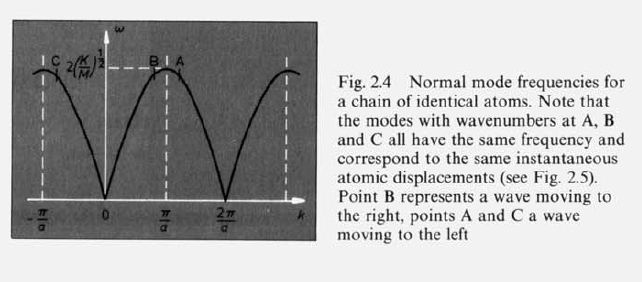|
|
| Line 78: |
Line 78: |
| Determine the speed of sound for this chain. What is the lowest frequency of long-wavelength sound corresponding to the optical branch? | | Determine the speed of sound for this chain. What is the lowest frequency of long-wavelength sound corresponding to the optical branch? |
|
| |
|
|
| |
| <math>\omega _{\alpha }(k)\approx C_{\alpha } k \;</math> | | <math>\omega _{\alpha }(k)\approx C_{\alpha } k \;</math> |
|
| |
|
| where | | where |
|
| |
|
| <math> C_{\alpha } \;</math> = speed of sound | | * <math>\omega_{\alpha } \;</math> = frequency |
| | * <math> C_{\alpha } \;</math> = speed of sound |
| | * <math> k \;</math> = ??? |
|
| |
|
| ==Problem 3== | | ==Problem 3== |
I have no idea what I'm doing - KimberlyWynne 03:11, 2 March 2009 (EST)
Diatomic harmonic chain
Problem 1
Given:
- a chain of atoms
- with alternating masses
 and
and 
- connected with elastic springs with constant

- moving only in the x-direction

Derive the dispersion relation  for this chain
for this chain
Index  for acoustic branch
for acoustic branch
Potential Energy 

![{\displaystyle \Rightarrow m{\ddot {U}}_{n}=-k[2U_{n}-U_{n-1}-U_{n+1}]=-m\omega U(t)\;}](https://wikimedia.org/api/rest_v1/media/math/render/svg/461b812664679855fe2267f3b2cb29ec477ba6b6)
Eigenvectors of Modes A and B (defined arbitrarily)


Band Matrix

Running waves through a solid

where

 = distance on some coordinate system
= distance on some coordinate system
![{\displaystyle \Rightarrow -m\omega ^{2}{\vec {u}}=-k[2-e^{ik\alpha }-e^{-ik\alpha }]\;}](https://wikimedia.org/api/rest_v1/media/math/render/svg/4f6a218fe9a00344679e78f96eb71bc19aa04fd9)
Derive and get:

Index for optical branch
for optical branch


![{\displaystyle \Rightarrow -m\omega ^{2}e^{ikna}=-k[2e^{ik(na)}-e^{ik(n+1)a}-e^{ik(n-1)a}]\;}](https://wikimedia.org/api/rest_v1/media/math/render/svg/bf21eaf0cd6fff39dbaadf7d6c171483dc3d65fb)
![{\displaystyle \Rightarrow m\omega ^{2}=k[2-(e^{ika}+e^{-ika})]\;}](https://wikimedia.org/api/rest_v1/media/math/render/svg/d5c7aad9c07cedc555f91814e4bb4eaa24a1810b)
![{\displaystyle \Rightarrow \omega ^{2}={\frac {2k}{m}}[1-cos(ka)]\;}](https://wikimedia.org/api/rest_v1/media/math/render/svg/6fd3a86e311f275e9c6e2dc3778c673e96de10fa)
![{\displaystyle \Rightarrow \omega ^{2}={\frac {\Delta k}{m}}{\frac {1}{2}}[1-cos(ka)]\;}](https://wikimedia.org/api/rest_v1/media/math/render/svg/89704ae3a53c5b0d68e89b57e0881bd41abd54fd)



Problem 2
Determine the speed of sound for this chain. What is the lowest frequency of long-wavelength sound corresponding to the optical branch?

where
 = frequency
= frequency = speed of sound
= speed of sound = ???
= ???
Problem 3
Sketch the motion of the atoms corresponding to the edge of the Brillouin zone, both for the optical and the acoustic branch.
Problem 4
Determine the Debye temperature for this system, and determine the form of the specific heat  in the limits of high and low temperatures.
in the limits of high and low temperatures.
Problem 5
Consider low temperatures ( ) and determine the wavelength of the most abundant phonons
) and determine the wavelength of the most abundant phonons  (Hint: note the analogy with Wien's Law!)
(Hint: note the analogy with Wien's Law!)








![{\displaystyle \Rightarrow m{\ddot {U}}_{n}=-k[2U_{n}-U_{n-1}-U_{n+1}]=-m\omega U(t)\;}](https://wikimedia.org/api/rest_v1/media/math/render/svg/461b812664679855fe2267f3b2cb29ec477ba6b6)






![{\displaystyle \Rightarrow -m\omega ^{2}{\vec {u}}=-k[2-e^{ik\alpha }-e^{-ik\alpha }]\;}](https://wikimedia.org/api/rest_v1/media/math/render/svg/4f6a218fe9a00344679e78f96eb71bc19aa04fd9)



![{\displaystyle \Rightarrow -m\omega ^{2}e^{ikna}=-k[2e^{ik(na)}-e^{ik(n+1)a}-e^{ik(n-1)a}]\;}](https://wikimedia.org/api/rest_v1/media/math/render/svg/bf21eaf0cd6fff39dbaadf7d6c171483dc3d65fb)
![{\displaystyle \Rightarrow m\omega ^{2}=k[2-(e^{ika}+e^{-ika})]\;}](https://wikimedia.org/api/rest_v1/media/math/render/svg/d5c7aad9c07cedc555f91814e4bb4eaa24a1810b)
![{\displaystyle \Rightarrow \omega ^{2}={\frac {2k}{m}}[1-cos(ka)]\;}](https://wikimedia.org/api/rest_v1/media/math/render/svg/6fd3a86e311f275e9c6e2dc3778c673e96de10fa)
![{\displaystyle \Rightarrow \omega ^{2}={\frac {\Delta k}{m}}{\frac {1}{2}}[1-cos(ka)]\;}](https://wikimedia.org/api/rest_v1/media/math/render/svg/89704ae3a53c5b0d68e89b57e0881bd41abd54fd)









